Comparison of Repeatability and Stability of Residual Magnetic Field for Stress Characterization in Elastic and Plastic Ranges of Silicon Steels
Abstract
:1. Introduction
2. Method and Experimental Setup
2.1. RMF Characterization Method and Domain Motion Behaviors
2.2. Experimental Setup
2.3. Sample Preparation
3. Results and Discussion
3.1. Magnetic Domain in Different Material Statuses
3.2. The Repeatability of RMF under Cyclic Stress Rounds in Different Material Statuses
3.3. Stability of RMF during Relaxation Time after Stress Was Removed in Different Material Statuses
4. Conclusions and Future Work
- (1)
- When stress/strain is applied, the domain image becomes clearer and the domain width becomes narrower. After the stress in the elastic range is removed, the magnetic domain returns towards the initial state, which mainly consists of striped domains. However, after the material reaches the plastic status, the striped domains change into new transverse domains. As a result, there is a significant difference between the magnetic domains in the elastic and plastic ranges.
- (2)
- When a small stress (0–90 MPa) is applied, this induces the domain rotation and domain wall displacement to proceed synchronously. When the applied stress continues to increase, the supplementary domain is completely rotated, and only the domain wall displacement continues. Thus, the RMF linearly increases with stress but the MV has almost no stress sensitivity to stress exceeding 90 MPa. After the stress is removed, the magnetic domain rotation and the domain wall displacement cannot return to the initial state, resulting in a change in the RMF value. The elastic stress increases the RMF, while the RMF changes in the opposite direction after the plastic strain is removed. In the cyclic stress rounds, because the small stress cannot change the current material status, there is no substantial change in the RMF under different stresses. Compared to the STD of the RMF after stress in each elastic stress round, materials in plastic status have better repeatability after cyclic stress rounds.
- (3)
- For samples that have just reached a plastic status, the MV decreases at first then increases to achieve oscillatory stability. The ASM has transient stability for a while in the reduction process and then falls to the state of oscillatory stability again. In the eight-hour relaxation time after the stress is removed, on the whole, the MV shows an upward trend, while the ASM shows a downward trend. For samples that have been a plastic material for a long time, the variation in the RMF after stress is more stable and less sensitive to stress. However, due to the limitation of residual stress caused by plastic deformation, the oscillation amplitude of the RMF of plastic materials is much smaller than that of elastic materials, and the stability of the RMF of plastic materials is more prominent.
- (4)
- Due to the accumulation of microscopic stress at the grain boundary, the materials in a plastic status with high grain boundary density produce more residual compressive stress and limit the domain motion behaviors, resulting in a smaller change range of the RMF with the highest grain boundary density. Therefore, plastic materials with high grain density have better stability and repeatability.
Author Contributions
Funding
Institutional Review Board Statement
Informed Consent Statement
Conflicts of Interest
References
- Dubov, A.A. A study of metal properties using the method of magnetic memory. Met. Sci. Heat Treat. 1997, 39, 401–405. [Google Scholar] [CrossRef]
- Shi, P.; Su, S.; Chen, Z. Overview of researches on the nondestructive testing method of metal magnetic memory: Status and challenges. J. Nondestruct. Eval. 2020, 39, 1–37. [Google Scholar] [CrossRef]
- Huang, H.; Qian, Z.; Liu, Z. Metal Magnetic Memory Technique and Its Applications in Remanufacturing; Springer: Singapore, 2021. [Google Scholar]
- Roskosz, M.; Fryczowski, K.; Tuz, L.; Wu, J.; Schabowicz, K.; Logoń, D. Analysis of the Possibility of Plastic Deformation Characterisation in X2CrNi18–9 Steel Using Measurements of Electromagnetic Parameters. Materials 2021, 14, 2904. [Google Scholar] [CrossRef] [PubMed]
- Liu, B.; Zhang, H.; He, L.; Ren, J.; Yang, L. Quantitative study on the triaxial characteristics of weak magnetic stress internal detection signals of pipelines based on the theory of magnetoelectric coupling. Measurement 2021, 177, 109302. [Google Scholar] [CrossRef]
- Leng, J.; Liu, Y.; Zhou, G.; Gao, Y. Metal magnetic memory signal response to plastic deformation of low carbon steel. NDT E Int. 2013, 55, 42–46. [Google Scholar] [CrossRef]
- Su, S.; Ma, X.; Wang, W.; Yang, Y.; Hu, J. Quantitative evaluation of cumulative plastic damage for ferromagnetic steel under low round fatigue based on magnetic memory method. Strain 2021, 57, e12379. [Google Scholar] [CrossRef]
- Meijers, P.C.; Jolink, C.T.; Tsouvalas, A.; Metrikine, A.V. Magnetic stray field measurements to identify and localise impact–induced plastic deformation in a steel structure. Int. J. Mech. Sci. 2022, 217, 106990. [Google Scholar] [CrossRef]
- Wang, H.; Dong, L.; Wang, H.; Ma, G.; Xu, B.; Zhao, Y. Effect of tensile stress on metal magnetic memory signals during on–line measurement in ferromagnetic steel. NDT E Int. 2021, 117, 102378. [Google Scholar] [CrossRef]
- Zeng, K.; Tian, G.; Liu, J.; Gao, B.; Qiu, F. Repeatability and stability study of residual magnetic field for domain wall characterization. J. Magn. Magn. Mater. 2019, 485, 391–400. [Google Scholar] [CrossRef]
- Liu, J.; Tian, G.; Gao, B.; Zeng, K.; Liu, Q.; Zheng, Y. Magnetic Barkhausen Noise Transient Analysis for Microstructure Evolution Characterization with Tensile Stress in Elastic and Plastic Status. Sensors 2021, 21, 8310. [Google Scholar] [CrossRef] [PubMed]
- Liu, J.; Tian, G.Y.; Gao, B.; Zeng, K.; Zheng, Y.; Chen, J. Micro–macro characteristics between domain wall motion and magnetic Barkhausen noise under tensile stress. J. Magn. Magn. Mater. 2020, 493, 165719. [Google Scholar] [CrossRef]
- Xie, S.; Wu, L.; Tong, Z.; Chen, H.-E.; Chen, Z.; Uchimoto, T.; Takagi, T. Influence of plastic deformation and fatigue damage on electromagnetic properties of 304 austenitic stainless steel. IEEE Trans. Magn. 2018, 54, 1–10. [Google Scholar] [CrossRef]
- Klyushnikov, V.A. Influence of plastic deformation temperature on ultrasonic and electromagnetic properties of austenitic steel. Mater. Today Proc. 2019, 19, 2320–2322. [Google Scholar] [CrossRef]
- Matsumoto, T.; Uchimoto, T.; Takagi, T.; Dobmann, G.; Ducharne, B.; Oozono, S.; Yuya, H. Investigation of electromagnetic nondestructive evaluation of residual strain in low carbon steels using the eddy current magnetic signature (EC–MS) method. J. Magn. Magn. Mater. 2019, 479, 212–221. [Google Scholar] [CrossRef]
- Pei, C.; Zhao, S.; Liu, T.; Chen, Z. A new method for plastic strain measurement with Rayleigh wave polarization. Ultrasonics 2018, 88, 168–173. [Google Scholar] [CrossRef] [PubMed]
- Cai, W.; Chen, H.-E.; Xie, S.; Li, Y.; Chen, Z.; Uchimoto, T.; Takagi, T.; Kensuke, Y. A study on influence of plastic deformation on the global conductivity and permeability of carbon steel. Int. J. Appl. Electromagn. Mech. 2014, 45, 371–378. [Google Scholar] [CrossRef]
- Fanlin, M.; Xiucheng, L.; Heyun, W.; Cunfu, H.; Bin, W. Characterization of Elastic and Plastic Behaviors in Steel Plate Based on Eddy Current Technique Using a Portable Impedance Analyzer. J. Sens. 2017, 2017, 8424012. [Google Scholar] [CrossRef]

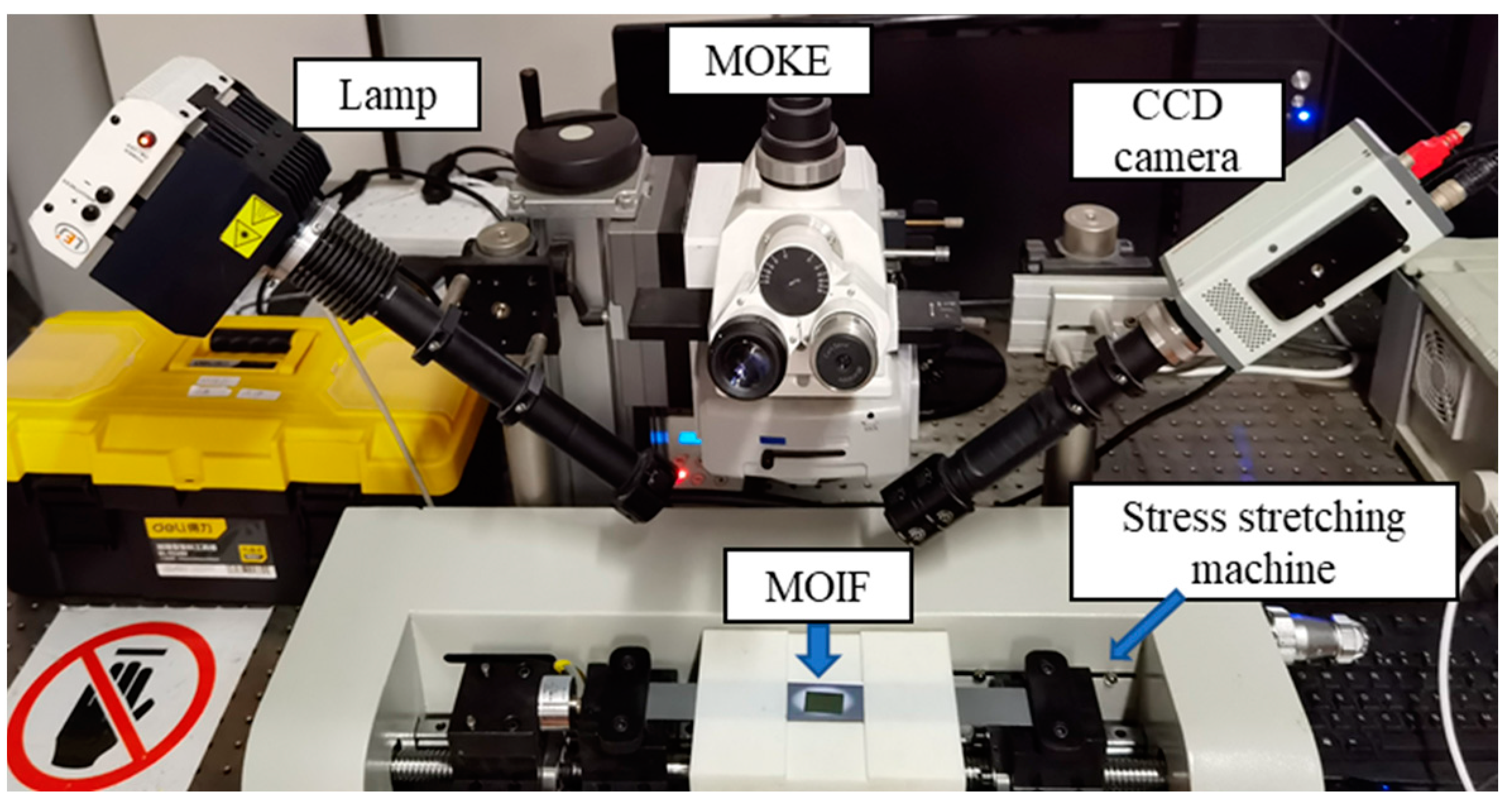
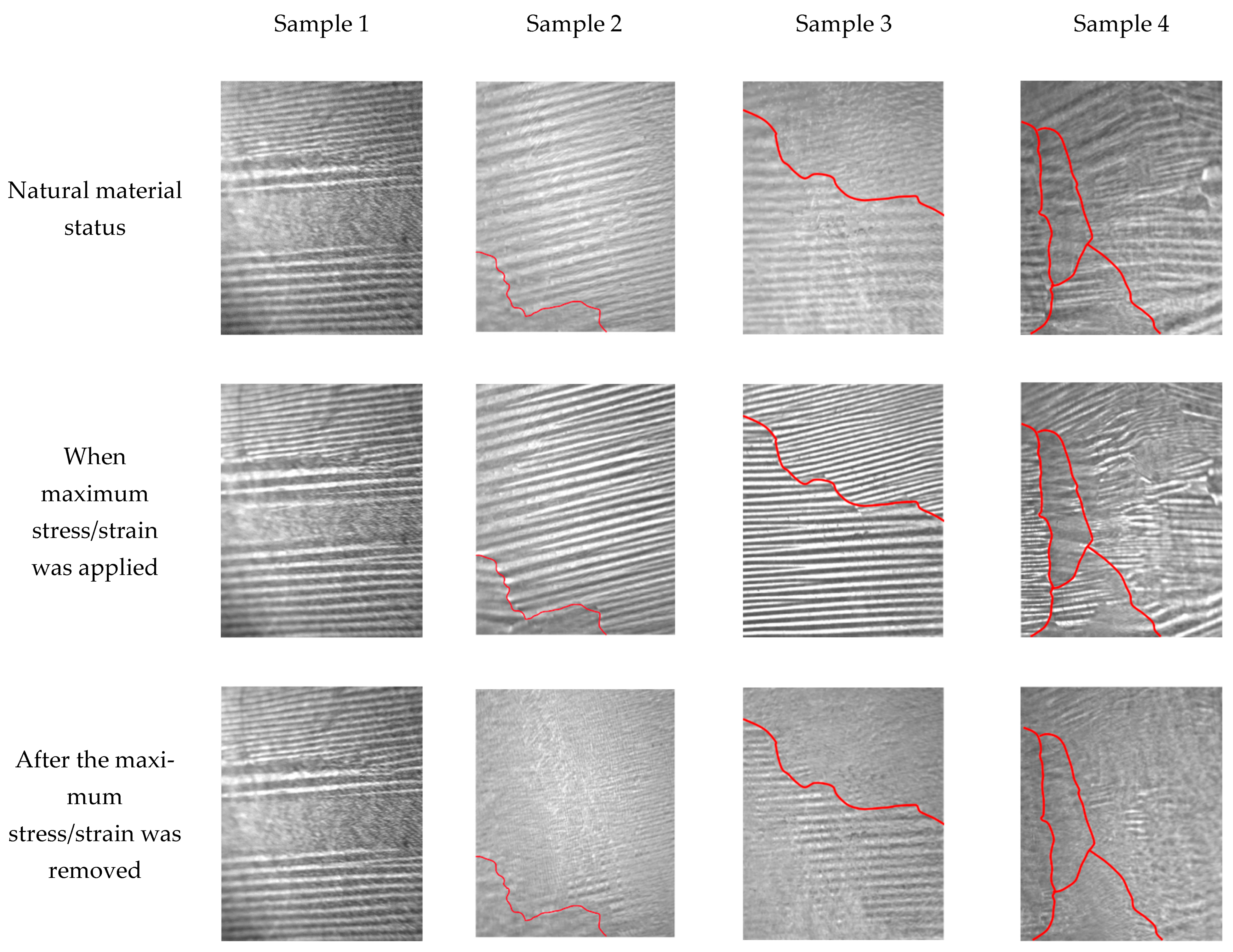

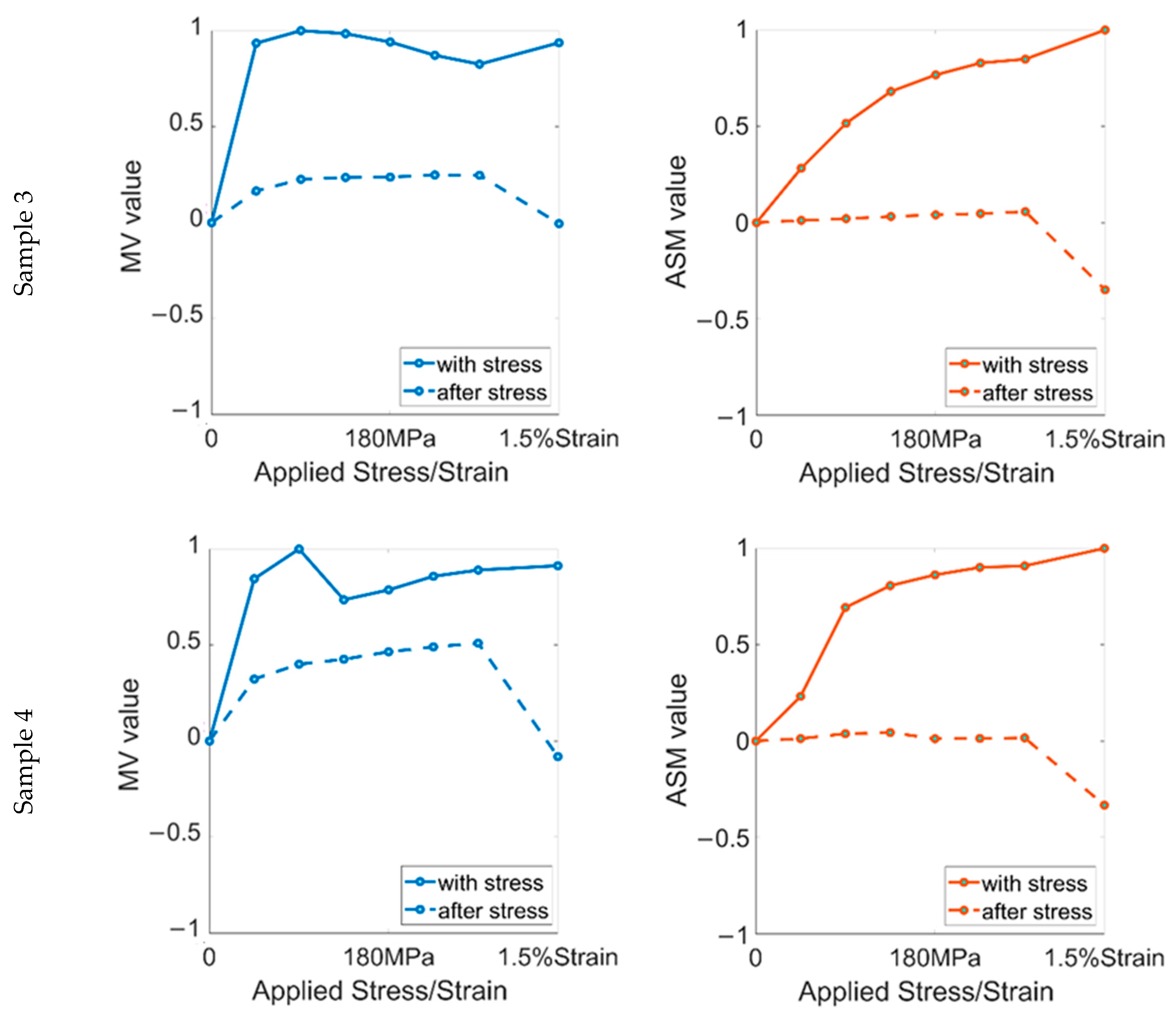
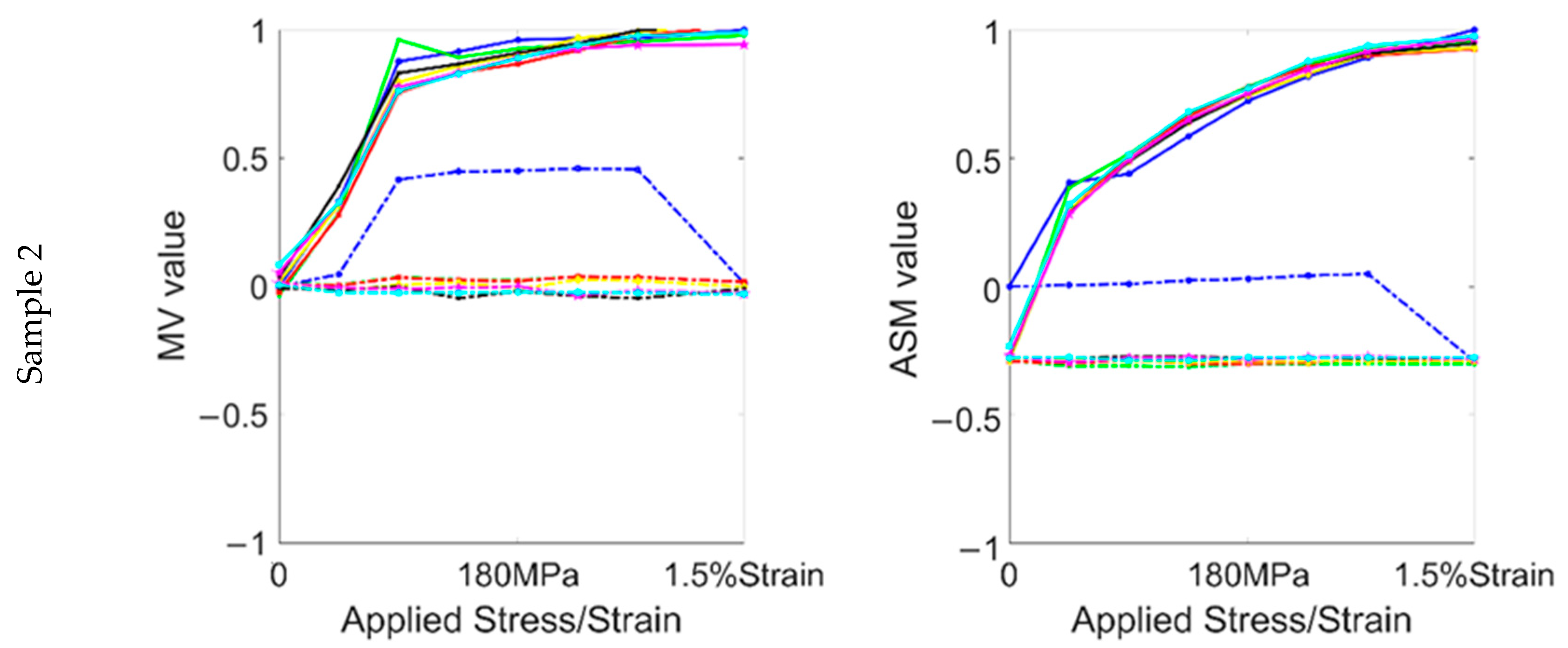
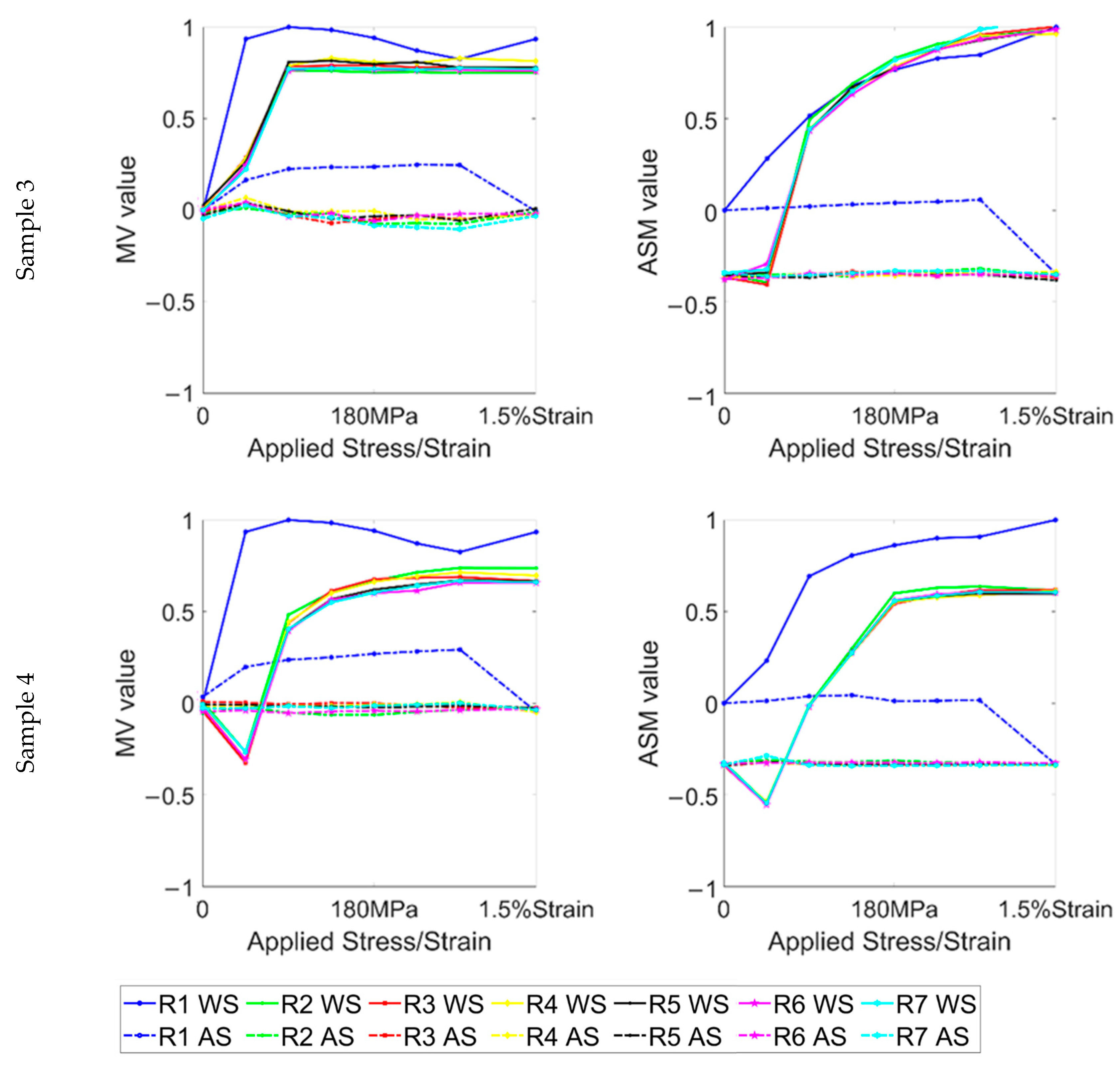



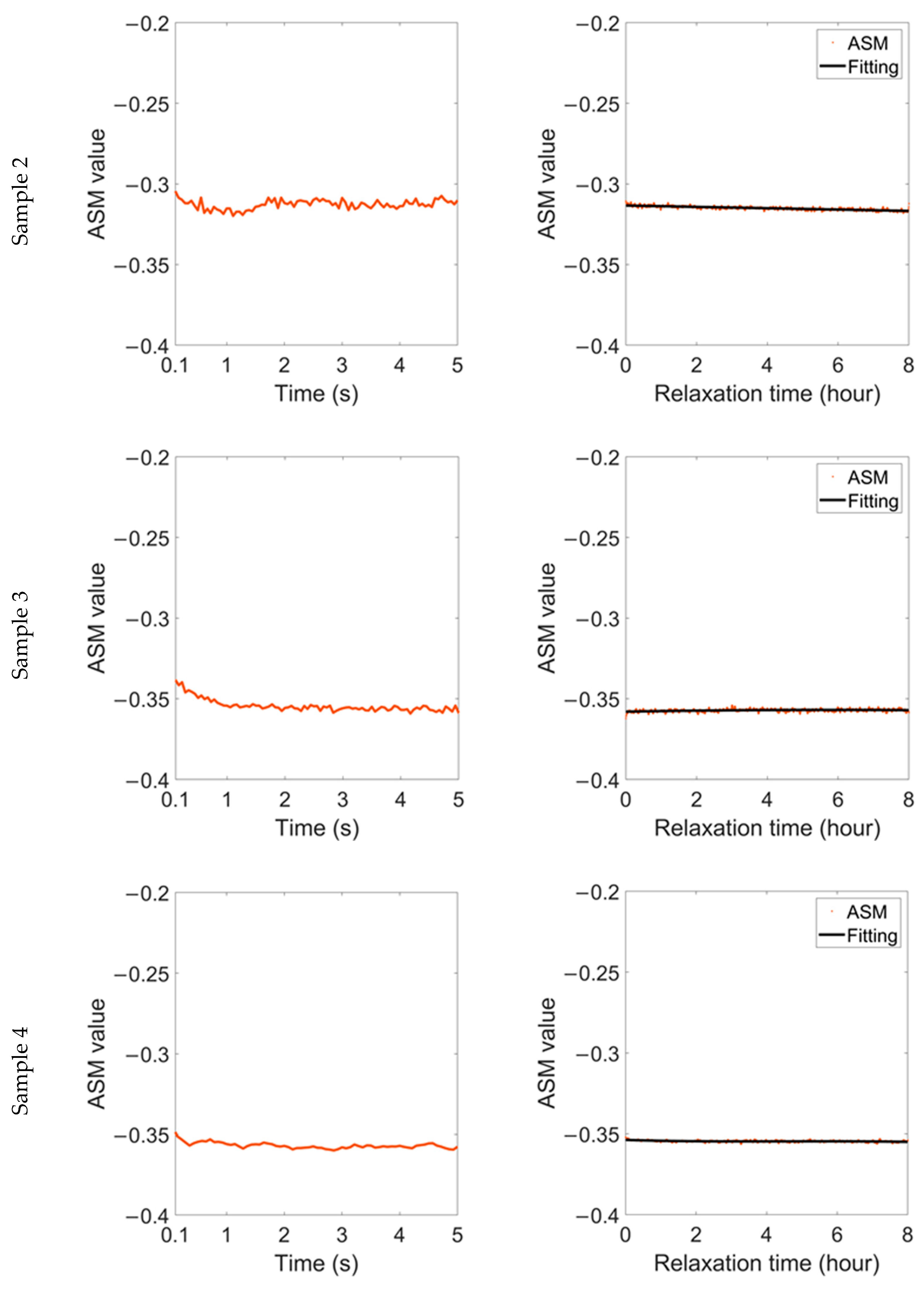
| Fe | Si | C | Mn | P | S | Al |
|---|---|---|---|---|---|---|
| Balance | 3.00–5.00 | 0.06 | 0.15 | 0.03 | 0.25 | 5.10–8.50 |
| 0 | 45 MPa | 90 MPa | 135 MPa | 180 MPa | 225 MPa | 270 MPa | 1.5% Strain | ||
|---|---|---|---|---|---|---|---|---|---|
| Sample 2 | MV | 0.007 | 0.012 | 0.024 | 0.029 | 0.020 | 0.037 | 0.035 | 0.021 |
| ASM | 0.007 | 0.014 | 0.012 | 0.015 | 0.011 | 0.012 | 0.010 | 0.010 | |
| Sample 3 | MV | 0.019 | 0.019 | 0.013 | 0.024 | 0.029 | 0.027 | 0.028 | 0.014 |
| ASM | 0.013 | 0.007 | 0.009 | 0.011 | 0.010 | 0.012 | 0.013 | 0.015 | |
| Sample 4 | MV | 0.024 | 0.015 | 0.021 | 0.023 | 0.024 | 0.018 | 0.019 | 0.010 |
| ASM | 0.005 | 0.015 | 0.007 | 0.008 | 0.009 | 0.006 | 0.005 | 0.005 |
Publisher’s Note: MDPI stays neutral with regard to jurisdictional claims in published maps and institutional affiliations. |
© 2022 by the authors. Licensee MDPI, Basel, Switzerland. This article is an open access article distributed under the terms and conditions of the Creative Commons Attribution (CC BY) license (https://creativecommons.org/licenses/by/4.0/).
Share and Cite
Zeng, K.; Tian, G.; Gao, B.; Liu, J.; Liu, Y.; Liu, Q. Comparison of Repeatability and Stability of Residual Magnetic Field for Stress Characterization in Elastic and Plastic Ranges of Silicon Steels. Sensors 2022, 22, 3052. https://doi.org/10.3390/s22083052
Zeng K, Tian G, Gao B, Liu J, Liu Y, Liu Q. Comparison of Repeatability and Stability of Residual Magnetic Field for Stress Characterization in Elastic and Plastic Ranges of Silicon Steels. Sensors. 2022; 22(8):3052. https://doi.org/10.3390/s22083052
Chicago/Turabian StyleZeng, Kun, Guiyun Tian, Bin Gao, Jia Liu, Yi Liu, and Qianhang Liu. 2022. "Comparison of Repeatability and Stability of Residual Magnetic Field for Stress Characterization in Elastic and Plastic Ranges of Silicon Steels" Sensors 22, no. 8: 3052. https://doi.org/10.3390/s22083052






